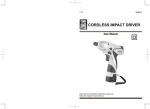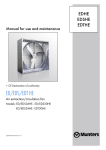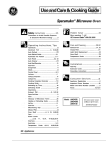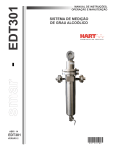Download Electronic Ignition
Transcript
~ .. I 8-52 ELECTRICAL-IGNITION SYSTEM-----------------·. ELECTRONIC IGNITION SYSTEM INDEX Page 68 Ballast Resistor Distributor Air Gap Adjustment Assembling the Distributor Distributor Disassembly Distributor Installation Distributor Removal Pick Up Coil-Replacement Shaft and Bushing Wear Test Centrifugal Advance Curve Electronic Ignition Tests With Tester Without Tester " 67 65 64 63 62 67 64 67 55 56 Electrical Diesel Injection Control System General Information Idle RPM Test Ignition Coil Ignition Timing Secondary Circuit Inspection Service Diagnosis Primary Circuit Service Diagnosis Secondary Circuit Service Procedures Spark Plugs Specifications Vacuum Advance Curve Vacuum Diaphragm Leak Test Page 68 52 61 68 62 59 53 54 59 60 142 68 68 GENERAL INFORMATION The Electronic Ignition System (Fig. 1) consists of the Battery, Ignition Switch, Dual Ballast Resistor (Fig. 2), Control Unit (Fig. 3), Coil, Distributor (Fig. 4), Spark Plugs and all their Wiring, Insulators and Connectors. The primary circuit consists of the battery, ignition switch, compensating (0.5 ohm) side of the ballast resistor, primary windings of the ignition coil, power switching transistor of the control unit, and the ve· hicle frame. IGNITION The secondary circuit consists of the coil secondary windings, distributor cap and rotor, spark plug wires, spark plugs, and vehicle frame. The compensating resistance maintains constant primary current with variation in engine speed. During starting this resistance is by-passed, applying full battery voltage to the ignition coil. In addition to the two basic circuits there are three other circuits. They are the pick up coil circuit, control unit feed circuit, and auxiliary ballast circuit. SWITCH DISTRIBUTOR ELECTRONIC CONTROL UNIT PH308 Fig. ••• ~_~ . J -Electronic Ignition System ._.,1,"'1",,1"'•.1•..•••••. -. .---------~------IGNITION ELECTRONIC IGNITION ,L-.•• ,~L- SYSTEM-ELECTRICAL 8-53 SYSTEM PRIMARY CIRCUIT DIAGNOSIS DIAGNOSIS PROCEDURE IS DETERMINED WITH THE USE OF - TESTER C·4503 WITH ADAPTER C4503·C r ON CERTAIN MODELS IT SYSTEM MAY REPLACEVEHICLE WIRING AND BE NECESSARY TO DISCONNECT HIDDEN HEADLAMPS, PRODUCE ALIGHTS LONG LIGHT ON BALLAST SET • TESTER r"., BALLAST RESISTOR TO START LIGHT ON ARE ON IGNITION SWITCH CONNECTIONS FIREWALL AND SELECTOR CONNECTOR FROM IGN ITION SWITCH NO DISTRIBUTOR WIRING HARNESS SECONDARYHIGH SET TESTER CONNECTIONS AT THE WILL NOT PRODUCE A SPARK IS IGNITION VOLTAGE ARCING. REPLACE IGNITION IF WIRING AND SHORT WIRE I NO IS DISTRIBUTOR YES HARNESS DISCONNECT PICKUP AND LIGHT ON IS DISTRIBUTOR YES I IF CHECK COIL VEHICLE SET MOUNTING OF SWITCH BETWEEN COIL PIECE AND RELUCTOR WHEEL. WIRING AND SELECTOR SET CHECK TESTER SELECTOR SWITCH TO POLE SWITCH IGNITION TO CONTROL UNIT IS YES IGNITION FOR BREAK UNIT WILL COIL SWITCH START IBUT CONNECTOR L1GHTON TOTO RUN ~ TESTER CONNECT REPLACE COIL.IF REPEATS REPLACE TURN VEHICLE IS TURN CONTROL UNIT OBTAIN INDICATION. ATESTER BALLAST OK SWITCH INO WIRING COVER MOTOR CIRCUIT TO SWITCH RUN YES VEHICLE IS NO GROUND YES SWITCH TO PICKUP COIL FOR DAMAGE AND GAP (.008\ENGINE, FUSE BLOCK NO ARE GOOD INDICATION. I REPLACE IGNITION f-.aSWITCH START LIGHT ON PICKUP LIGHT ON WHILE STARTER ISCAP, CRANKING ARE GOOD CONNECTIONS ARE GOOD OBTAIN A BALLAST OK IGNITION SWITCH PICKUP ARE GOOD SWITCH WIRE HARNESS IF TESTER CHECKS IGNITON SYSTEM GOOD, CLEAN SWITCH IFCHECK CONTROL I CONTROL UNIT DISTRIBUTOR CONNECTIONS OR SHORT CONDITION TURN IGNITION REMOVE AND CHECK DISTRIBUTOR EXAMINE ! LEADS RESISTOR IF SYSTEM OK iOIlI YES ON MODELS EQUIPPED WITH ~ + DISCONNECT THE ISHEADLAMP ~ ~ ~ TO RUN ., ~ NO IGNITION I YES I I - Y--- I I WIRE HARNESS. i .,--J I I PU691 --~--~-----------------------------" ELECTRICAL-IGNITION 8-54 ELECTRONIC IGNITION * COIL CABLE TO PLUG PROPERLY OR GROUND [N RICH TOR DISTRIBUCAP TERM[NAL FUEL MIXTURE TOWER Oil IN FOULED CRACKED COIL WIRE COIL DISTRIBUTOR CAUSING CAP CRACKED CRACKED TOWER TOWER [N [NBUT VOLTAGE ONE LINES OR MORE ARE NOT ALL FIRING MUCH HIGHER THAN TO NOT BEING SPARK PLUG SHORTED SPARK NOT PLUG WORKING PLUG WIRE BALANCED ONE SIDE LEAK PRIMARY CIRCUIT '*HIGH E,G,R, STUCK VALVE OPEN CRACKED LOW COIL OUTPUT OTHERS INSULATOR CAP TERMINAL LINES ARE THE CARBURETOR 'DEFECTIVE INTAKE VACUUM SPARK IDLE IGNITION SYSTEM (B CYLINDER ONLY)* ABNORMALLY LOW DISTRIBUTOR SAME, MIXTURE BUT NOT CRACK'ED OR BROKEN SPARK LOW PLUG COMPRESSJON CERAMIC MUCH LOWER THAN RICHER THAN LEAD FOULED ONE NOT VOLTAGE OR ALL MORE FIRING LINES BUT ARE SPARK PLUG WIRE ONE SIDE ALL FIRING VOLTAGE INSULATION CAUS[~G PROBLEM MECHANICAL IN CYLINDER RESISTANCE IN SPARK PLUG CABLE (8 CYLINDER ONLY)* CYLINDERS SPARK PLUG FOULED (DEPOSITS) *OTHER BUT NOT ALL NOT FIRING ONE OR MORE, SPARK PLUG 'I< DEFECTIVE I BALANCED PROCEDURE SCOPE PATTERN IS DETERMINED AN AUTOMOTIVE BY TYPE NOTOSCILLOSCOPE PROPERLY COMPRESSION DUEA OF * I tII OW ENGINE K OR BURNS [N • SYSTEM ** ** * SYSTEM SECONDARY CIRCUIT DIAGNOSIS ;.* I DIAGNOSIS PRO PERLY SEA TED ONIN W[RE TERMINAL DUE CAUSING ARCING BREAK OR (CRUST ABURNS TION) DEFECTIVE ARCING TO GROUN~ MIXTURE NOT CARBURETOR CORRODED SPARK IDLE PLUG * ALL TESTS AND REPAIRS ARE DESCRIBED IN APPROPRIATE SECTION OF SERVICE MANUAL. * * SPARK PLUGS (DO NOT FOUL BY THEMSELVES.)CHECK FOR. WHAT CAUSED PLUG TO FOUL. INSTALLING NEW SPARK PLUGS WILL NOT CORRECT FOULING CONDITION. PK398A t IGNITION AUXILIARY NORMAL SYSTEM-ELECTRICAL 8-55 BALLAST RESISTOR BALLAST RESISTOR PD453 Fig. 2-Dua' Ballast Resistor Two circuits are used to operate the circuitry of the control unit. These are the auxiliary ballast circuit which uses the 5 ohm section of the dual ballast resistor and the control unit feed circuit. The pick up circuit is used to sense the proper timing for the control unit switching transistor. The reluctor rotating with the distributor shaft produces a voltage pulse in the magnetic pickup each time a spark plug should be fired. This pulse is transmitted through the pickup coil to the power switching transistor in the control unit and causes the transistor to interrupt the current flow through the primary circuit. This break in the primary circuit induces a high voltage in the secondary coil circuit and fires a spark plug. The length of time that the switching transistor allows the flow of current in the primary circuit is determined by the electronic circuitry' in the control unit. This determines "dwell/t• Dwell is not adjustable. There is no means provided to change it because changes are not necessary. The reading obtained with a dwell meter has no TRANSISTOR Fig. 4-E'edronic Distributor significance in diagnosing or servicing the ignition system. Since dwell affects ignition timing, periodic checks of timing become unnecessary after basic igni. tion timing is set .. Ignition maintenance is reduced to inspection of the distributor cap, rotor, wiring, and the cleaning and changing of spark plugs as needed. ELECTRONIC IGNITION TESTS With Tester C4503 and Adaptor C4503-3 (Fig. 5) WARNING: PRIOR TO TESTING THE ELECTRONIC IGNITION SYSTEM IN ANY VEHICLE, PLACE THE VEHICLE TRANSMISSION IN NEUTRAL OR PARK POSITION (PARK BRAKE APPLIED AND GEAR SE· LECTOR IN NEUTRAL ON MANUAL TRANSMISSION CARS) AND TURN IGNITION SWITCH TO THE OFF OR LOCK POSITION. Test Preparation CAUTION: The vehicle must have a fully charged 12 volt battery (minimum specific gravity 1.220 temperature corrected), for the tester to accurately analyze the ignition system. Do not proceed with test unless battery meets specifications. F;g. 3-E'edron;c Contro' Unit (1) Connect the Chrysler Adaptor Assembly (C45033) to the Tester cable and rotate Tester Selector switch to the Off position. (2) With the ignition switch in ItOfflt position. remove screw attaching wiring harness connector to control unit and remove connector. (3) Connect female lead of tester wiring harness to control unit and male lead of tester to disconnected 8-56 ELECTRICAL-IGNITION SYSTEM'-----------------t If the green Control Unit light comes On, and a good high intensity spark is present, proceed to next Step. (b) If the green Control Unit light does not come On or the No Ground light does come On, refer to the diagnostic Chart. Distributor Pick-Up Coil Position (1) Rotate the Selector switch to Distributor Pickup position. (2) Observe that the Distributor Pickup light comes On. All other lights should remain Off. If the green Distributor Pickup light comes On, the distributor pickup is good. Proceed to next Step. If the green Distributor Pickup light does not come On, refer to the diagnostic Chart. Ignition Switch Position-Run and Start Lights (1) Rotate the Selector switch to Ign Switch position. (a) Observe that both the Run and Start lights are CONNECT TO COil POSITIVE BATTERY POST Fig. 5-E'edronic PU692 'gnition Tester C4503 Off. (b) Place the vehicle ignition switch in the On or Run position and observe that only the green Run lead from control umt. This puts tester into vehicle ignition system. (4) Disconnect coil secondary wire from distributor cap center tower. Provide a 1/4 inch air grap from coil secondary wire to engine block. (5) Connect the Tester alligator type battery clips to the vehicle battery. Red clip to Battery, Positive + Terminal; Black clip to Battery, Negative - Terminal. (6) Connect the Adaptor alligator clip to the ignition coil primary "Bat" terminal point. CAUTION: light comes On. (c) If the green Run light does not come On, refer to diagnostic Chart. (d) Turn the vehicle ignition switch to the Start position without cranking the engine, and observe that the green Start light comes On. Both the Run and Start lights should now be On. (e) If both the Run and Start lights do not come On, refer to the diagnostic Chart. Tester damage can result from erroneous connection of red test lead to coil primary "Ecu·" terminal. power on for extended periods of time. Primary Position-Coil and Ballast Lights (1) Rotate the Tester Selector switch to Primary position. (a) Observe that the Coil and Ballast lights come On. All other lights should remain Off. (b) If the green Coil and Ballast lights come On, the primary circuit and ignition ballast resistor are good. Proceed to next Step. Control Unit Position (1) Rotate the Selector switch to Control Unit position. (a) Observe that the Control Unit light comes On and that a high voltage spark is present between the coil secondary wire and the engine block. Observe the length and intensity of the spark as the wire is slowly pulled away from the block to increase the spark gap. A long blue spark indicates that the coil Ci'.ltputis good. CAUTION: Do not leave tester in test mode with ELECTRONIC IGNITION TESTWITHOUT TESTER Do not substitute this test if tester is available. To properly test the Electronic Ignition System the testers C-4503 with adaptor, C-4503-3should be used. But in the event they are not available, the system, (Fig. 6) may be tested using a voltmeter with a 20,000 ohm/volt rating and an ohmmeter which uses a 1-1/2 volt battery for its operation. Both meters should be in calibration. When Ignition System problems are suspected, the following procedure should be followed: (1) Visually inspect all secondary cables at the coil, distributor and spark plugs for cracks and tightness. (2) To check wiring harness and connections. (a) Check primary wire at the ignition coil and ballast resistor for tightness. If the above checks do not determine the problem, the following steps will determine if a component is faulty. .-----------------IGNITION DUAL BALLAST AUXILIARY 8-57 SYSTEM-ELECTRIC RESISTOR FIREWALL 5 OHMS COIL + IGNITION SWITCH BATTERY FEED DISTRIBUTOR CONNECTOR WIRING HARNESS CONNECTOR DISTRIBUTOR BATTERY + AMPMETER PF1ll5 Fig. 6-Eleetronic Ignition System Wiring Schematic (b) Check and note battery voltage reading using voltmeter. (c) Remove the multi-wiring connector from the control unit. CAUTION: Whenever removing or installing the wiring harness connector to the control unit, the ignition switch must be in the "Off" position. (d) Turn the ignition switch "On". (e) Connect the negative lead of a voltmeter to a good ground. (f) Connect the positive lead of the voltmeter to the wiring harness connector cavity #1. Available voltage at cavity #1 (Fig. 7) should be within 1 volt of battery voltage with all accessories off. If there is more than a 1 volt difference, (Fig. 7) shows the circuit that must be checked. (g) Connect the positive lead of the voltmeter to the wiring harness connector cavity #2. Available voltage at cavity #2 (Fig. 8) should- be within 1 volt of battery voltage with all accessories off. If there is more than a 1 volt difference, (Fig. 8) shows the circuit that must be checked. (h) Connect the positive lead of the voltmeter to the wiring harness connector cavity #3. Available voltage at cavity #3 (Fig. 9) should be within 1 volt of battery voltage with all accessories off. If there is more than a 1 volt difference, (Fig. 9) shows the circuit that must be checked. (i) Turn ignition switch "Off". (3) To check distributor pickup coil. (a) Connect an ohmmeter to wiring harness connector cavity #4 and #5 (Fig. 10). The ohmmeter resistance reading should be between 150 and 900 ohms. If the reading is higher or lower than specified, disconnect the dual lead connector coming from the VOLTMETER "00 o + 0' 000 00 PFll16 Fig. 1-Testing Cavity Number One 8-58 ELECTRICAL-IGNITION SYSTEM----------------+ ElJ I OHM Ell' VOLTMETER + - METER C5J o 000 o 0 00 PF1119 PFll17 fig. 'O-Testing Pick-up Coi' at Wiring Harness Connector, Cavities Four and five fig. B-Testing Cavity Number Two distributor (Fig. 11). Using the ohmmeter, check the resistance at the dual lead connector. If the reading is not between 150 and 900 ohms, replace the pick up coil assembly in the distributor. If reading is within above specifications check the wiring harness between the control unit and dual lead connector. (b) Connect one ohmmeter lead to a good ground and the other lead to either connector of the distributor. Ohmmeter should show an open circuit. If the ohmmeter does show a reading, the pick up coil in the distributor must be replaced. (4) To check electronic control unit ground circuit (a) Connect one ohmmeter lead to a good ground and the other lead to the control unit connector pin #5 (Fig. 12). The ohmmeter should show continuity between the ground and the connector pin. If continuity does not exist, tighten the bolts holding the con· trol unit to the fire wall. Then recheck. If continuity does still not exist, control unit must be replaced. (5) Reconnect wiring harness at control unit and distributor. Whenever removing or installing the wir- switch must be in the "Off" position. (6) Check air gap between reluctor tooth and pick up coil. To set the gap (Fig. 13), refer to "Air Gap Adjustment" under "Service Procedures." (7) Check ignition secondary. (a) Remove the high voltage cable from the center tower of the distributor. Hold the cable approximately 3/16 inch from engine. Crank engine. (b) If arcing does not occur, replace the control unit. (c) Crank the engine again. If arcing still does not occur, replace the ignition coil. (8) Summary Remember: The electronic ignition tester does a complete job of testing circuits and components. If a problem does not show up when making the voltage checks, coil resistance checks, or ground continuity checks it is likely the control unit or coil is faulty. It is unlikely that both units would fail simultaneously. However, before replacing the control unit make sure ing harness connector to the control unit, the ignition OHM METER o 5 OHMS-r~o: +rO:'\ -vt.J o + PFll20 PF1ll8 Fig- 9-Testing Cavity Number Three A fig. "-Testing Pick-up Coil at Distributor Lead Connector .'----------------IGNITION 8-59 SYSTEM-ELECTRICAL no foreign matter is lodged in or blocking the female terminal cavities in the harness connector. If clear, try replacing control unit or coil to see which one restores secondary ignition voltage. SERVICE PROCEDURES All procedures apply to both 6 and 8 cylinder engines, except where noted. SECONDARY CIRCUIT INSPECTION Distributor Cap Remove distributor cap and inspect the inside for flashover, cracking of carbon button, cracking of cap, and burned, worn or grooved terminals. If any of these conditions are present the distributor cap should be replaced. Light scaling of the terminals, caused by the arcing of the spark from the rotor can be cleaned with a sharp knife. If heavy scaling of the terminals is present, the distributor cap should be replaced. A cap that is greasy or dirty or has a powdered like substance on the inside should be cleaned with a solution of warm water and a mild detergent. Scrub with a soft brush, thoroughly rinse, and dry by blowing with compressed air or a clean soft cloth. Rotor Inspect the rotor for cracks, excessive burning of the tip, and proper tension of the spring terminal. If any of these conditions are present the rotor should be replaced. CAUTION: Presence of silicone grease on the metal portion of the rotor is normal and should not be removed. Light scaling of the tip can be cleaned with a sharp knife, however, if heavy scaling is present the rotor should be replaced. condition. Nipples should fit tightly on the coil cap towers and spark plug cover should fit tight around spark plug insulators. Cable connections that are loose will corrode and increase the resistance and permit water to enter the towers causing ignition malfunction. To maintain proper sealing between the towers and nipples, cable and nipple assemblies should not be removed from the distributor or coil towers unless nipples are damaged or cable testing indicates high resistance or broken insulation. Clean high tension cables with a cloth moistened with a non-flammable solvent and wipe dry. Check for brittle or cracked insulation. When testing secondary cables for punctures and cracks with an oscilloscope follow the instructions of the equipment manufacturers. If an oscilloscope is not available, secondary cables can be tested as follows: CAUTION: On catalytic converter equipped vehicles do not leave anyone spark plug wire disconnected any longer than necessary during test or possible heat damage to catalytic converter will occur. Total test time must not exceed ten minutes. (a) Engine not running, connect one end of a test probe to a good ground, other end free for probing. (b) Disconnect cable at spark plug end. Insulate cable end from grounding. (c) With engine running, move test probe along entire length of wire. If punctures or cracks are present there will be a noticeable spark jump from the faulty area to the probe. Secondary coil wire may Spark Plug Wires Check the high tension cable connections for good contact at the coil and distributor cap towers and at the spark plugs. Terminals should be fully seated. The nipples and spark plug covers should be in good OHM METER ~AIRGAP PF1l24 PFll21 Fig. 12-1esting Ground Circuit Fig. 13-Air Gap Adjustment +----------------IGNITION SYSTEM-ELECTRICAL 8-67 (9) Position reluct or keeper pin into place on reluctor sleeve. (10) Slide reluctor down reluctor sleeve and press firmly into place. (11) Lubricate the felt pad in top of reluctor sleeve with 1 drop of light engine oil and install the rotor. (4) Adjust air gap so that contact is made between reluctor tooth, feeler gauge, and pick up coil tooth. (5) Tighten hold down screw. (6) Remove feeler gauge. No force should be required in removing feeler gauge. (7) Check air gap with .008 feeler gauge. A .008 feeler gauge should not fit into air gap. Caution: A PICK UP COILREPLACEMENT .008 feeler gauge can be forced into air gap. Do not force feeler gauge into air gap. Removal Remove distributor. (2) Remove reluctor by prying up from bottom with two pry bars or screw drivers (maximum width 7/16 inch). (1) CAUTION: Be careful not to damage reluctor teeth. (3) Remove two screws attaching vacuum control unit to distributor housing if so equipped. (4) Disconnect vacuum control arm from upper plate and remove control unit. (5) Remove pick up coil leads from distributor housing. (6) Remove two screws attaching lower plate to distributor housing. (7) Lift out lower plate, upper plate, and pick up as an assembly from housing. (8) Remove upper plate and pick up coil assembly from lower plate by depressing retainer clip on underside of lower plate and moving it away from attaching stud. Pick up coil is not removable from upper plate. They are serviced as an assembly. Installation Place a small amount of distributor cam lubricant on upper plate support pins located on lower plate. (2) Position upper plate on lower plate, install reo tainer clip, depress and lock into place. (3) Position lower plate, upper plate and pick up coil assembly in distributor housing, install mounting screws and tighten securely. (4) Attach vacuum control arm to upper plate, position control into place on distributor housing, install mounting screws and tighten securely if so equipped. (5) Install pick up coi1leads to distributor housing. (6) Install reluctor. Refer to "Assembling the Distributor" for correct installation procedures. (7) Install distributor. (1) (8) Apply vacuum to vacuum unit and rotate governor shaft. Pickup pole should not hit reluctor teeth. Gap was not properly adjusted if hitting occurs. If hitting occurs on only one side of reluctor the distributor shaft is probably bent. Replace governor and shaft assembly. CENTRIFUGALADVANCECURVE Carefully mount distributor assembly (less cap and rotor) in a reliable stroboscope-type distributor tester. It is important that the appropriate adapter for checking electronic type distributors is connected to the distributor stand and that the instructions for its usage are followed. After this is done proceed with test as follows: (1) Turn the selector switch to the 6 or 8 cylinder position and motor switch to the correct direction of rotation. Refer to Distributor Specifications for proper rotation. (2) Regulate tester speed control to operate distributor at 200 distributor rpm. (3) Align the "0" of distributor tester degree with any of the arrow flashes. (4) Adjust tester speed control to operate distributor at speeds called for under "Specifications" and observe arrow flashes opposite tester degree ring to determine degrees of advance. (5) If advance is not according to specifications, replace with correct distributor shaft assembly (shaft, reluctor sleeve, governor weights as a complete assembly). PICK-UP COIL ADJUSTMENT I 1 AIR GAPADJUSTMENT(Fig. 26) (1) Align one reluctor tooth with pick up coil tooth. (2) Loosen pick up coil hold down screw. (3) Insert .006 non-magnetic feeler gauge between reluctor tooth and pick up coil tooth. NON-MAGNETIC FEELER GAUGE Fig. 26-Air Gap Adiustment °F570


















